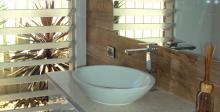Kitchen design guide
Single wall kitchens
Also called 'straight kitchens' or 'single line' kitchens, these types of kitchens take up as little room as possible. Straight kitchens are best suited to small areas, for people who aren't likely to do lots of cooking.
Minimalist kitchens
As the name suggests, minimalist kitchens employ flat, straight surfaces, muted colours and ultra-modern appliances and fittings. Minimalist kitchens look striking, but may not be practical for every home.
Provincial or country style kitchens
Kitchens in the 'French Provincial' style typically feature white, panelled cabinetry, decorative edging, knobs and handles, light-coloured timber surfaces and other aspects of the style, reminiscent of provincial France.
Flat pack kitchens
Flat pack kitchens are popular these days because they're affordable and come in a range of styles and designs - but they also have their limitations. Find out how flat pack kitchens compare in practical terms.
Amount of bench space
The amount of benchtop space you have available in your kitchen and where it's located will often determine how effective - or frustrated - you are when working in the kitchen. Find out how much you need.
How much kitchen storage space do I need?
When planning your kitchen, it's vital to ensure that you take into account just how much space you'll need, and for what sorts of things. Find out how much storage space you should plan for in your kitchen.
Butler's pantries
A butler's pantry is a small room separate from the main kitchen, typically used as a staging area in which to prepare meals, or to store cutlery, crockery and table linen. Butler's pantries best suited to bigger homes.
Undermount and top mount sinks
Not sure if you need an undermount sink or a top mount sink? Not sure what either actually is? Find out more about the two different types, and how they differ from each other.
Sink size and number of basins
The size and number of basins you choose for your kitchen is a very practical choice - and if you're short on space, getting the balance right is crucial. Find out how many basins you should get for your kitchen sink.
Stainless steel kitchen sinks
Stainless steel is very popular for sinks these days because it's affordable, hygienic, tremendously heat resistant, dead easy to clean and available in all kinds of shapes and sizes.
Acrylic kitchen sinks
Acrylic sinks are lightweight, come in all shapes and sizes and have the unique benefit of being able to be made to look like porcelain, sandstone or even granite.
Porcelain or ceramic kitchen sinks
Porcelain sinks (also called 'ceramic sinks') offer a classy, traditional look, and have been used in kitchens for centuries. While porcelain is extremely resistant to heat, it is susceptible to chipping and wear.
Granite, marble and other stone kitchen sinks
Stone sinks (including granite) are relatively expensive and heavy - but they look amazing in the right setting, are extremely durable and are very hygienic.
Timber sinks
Timber sinks are normally built using techniques borrowed from boat making. These types of basins offer a unique, custom finish, although care needs to be taken to ensure that they remain waterproof.
Enamel over cast iron kitchen sinks
Enamel-coated cast-iron sinks are making a real comeback these days, thanks to their amazing durability and their retro appeal. New cast-iron sinks are often made to look like the older varieties.
Pull-down and pull-out taps
Many people these days are opting to install pull-down and pull-out taps in their kitchen because of the convenience they afford when doing the dishes. Find out what these types of taps are, and why they're so popular.
Mixer taps
Mixer taps have become the standard in kitchens these days - and with good reason. Find out what mixer taps are, and what their benefits are over separate hot and cold taps.
Modern or contemporary kitchens
These days, modern or contemporary style kitchens are normally subtle and restrained in terms of detail, and incorporate lots of solid, flat surfaces rather than ornate decorative features.
Glass splashbacks
Glass splashbacks are typically installed as a single piece, look fantastic and do away with the need for grouting and related maintenance. They are, however somewhat expensive and require a little care.
Tile splashbacks
Tile splashbacks are very popular and offer a tremendous amount of freedom in terms of colour and design, for just about any budget. Tiles do require extra effort to install and maintain though.






















